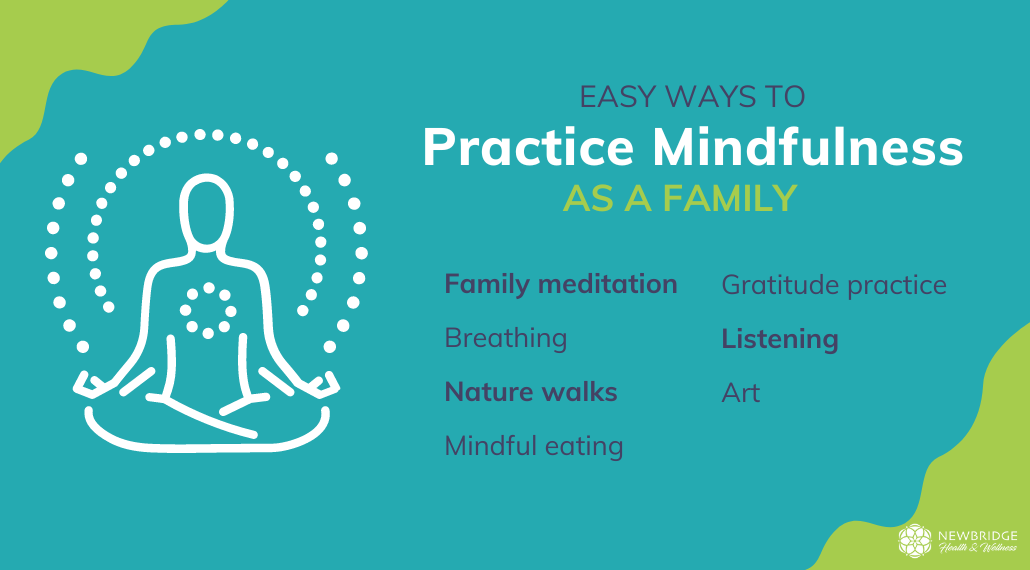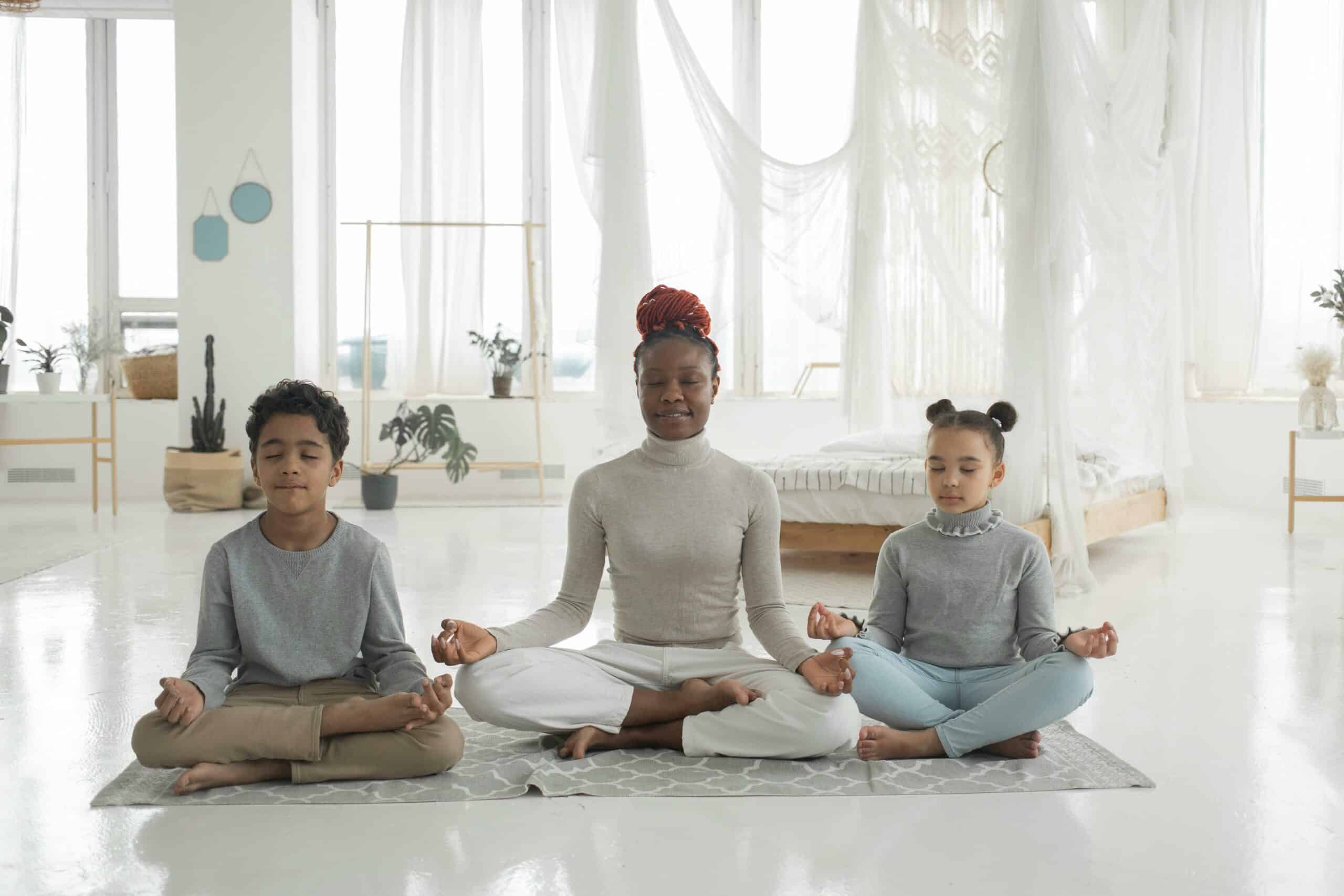Stress and anxiety can have a profound impact on the overall health of adults and children. In today’s fast paced world, it is more important than ever to prioritize mental health, especially for our families and kids, and a mindfulness practice can be an important piece of the wellbeing puzzle. Here, we will delve into the science behind mindfulness, explain what it is, and share some techniques that will help you get started with mindfulness practices.
Are you ready to prioritize your mental health, but need support? Contact us today to discuss our integrative provider team and ways we can help you get on track with better mental health. Newbridge offers clinical counseling, functional medicine, and other services like neurotherapy.
Mindfulness: An evidence-based way to support your mental health
The practice of mindfulness has increased in popularity recently, and with good reason. According to the American Psychological Association, mindfulness is defined as “awareness of one’s internal states and surroundings” and it “can help people avoid destructive or automatic habits and responses by learning to observe their thoughts, emotions, and other present-moment experiences without judging or reacting to them.”
Mindfulness has been shown to:
- Reduce chronic stress: Chronic stress can lead to numerous health issues, both physical and mental. Mindfulness Based Stress Reduction (MBSR) has been shown to lower cortisol (the stress hormone), leading to decreased stress and anxiety.
- Enhance emotional regulation: Mindfulness helps individuals become more aware of their emotions and respond to them in a healthier manner.
- Boost attention and focus: Mindfulness practices, such as meditation, have been linked to improved attention and concentration. This can be particularly beneficial for children and adolescents who may struggle with attention issues such as at school, or adults at work.
- Promote resilience: Mindfulness cultivates resilience by helping individuals develop a more balanced perspective on life’s challenges. It teaches us to accept difficult experiences without judgment and bounce back more effectively.
Putting mindfulness into practice
We all want to feel our best; just as we make efforts to take care of our physical health by eating healthy foods, exercising, and seeing our doctors when we are sick, we also need to prioritize our mental health through actions and habits.
But in our busy lives, we often rush from one thing to the next, leaving no time for a practice that supports both our mind and body. But adding mindfulness to your daily routine doesn’t have to mean a huge time commitment or learning a complicated meditation technique. One easy way to get started is to simply make space for ourselves – i.e., taking pauses during the day, for just a few moments, to take note of our thoughts and feelings.

Once we have made more room for these pauses, we can adopt a more structured – yet still brief and easy-to-accomplish – mindfulness practice. This can be in the form of meditation, breathing, gratitude practices, or other exercises. Here are some options to help get you started, without much disruption to your daily life:
Family meditation: Dedicate just a few minutes each day to sit down as a family and practice meditation together. Using a guided resource to help you get started can help. And remember, consistency is key when forming a new practice – just a few minutes, preferably at the same time each day, will make all the difference. Some great meditation apps that can be downloaded and used in the comfort of your daily life include Headspace, Calm, and Healthy Minds Program.
Breathing exercises: Breathing exercises are a powerful tool that you can use at anytime and anywhere. Plus, they are very easy to teach kids. Here are some to get you started:
- 5 finger breathing: Stretch out your hand, and trace your fingers; Breathe in as you trace one side of your finger, and then hold as you move down the other side. Continue until you have finished tracing your hand, and consider repeating if needed. Remember to take big deep belly breaths. Follow along with this video.
- Square breathing: Trace a square on the palm of your hand or knee. Breathe in as you trace one side of the square – 1-2-3-4, and then hold as you move along another side of a square – 1-2-3-4, then breathe out along the third side – 1-2-3-4, and then hold for 1-2-3-4. Repeat three times or more. Here’s a quick how-to video with our clinical counselor.
- Belly breathing: Place your hands on your abdomen so that you can feel your belly button. Breathe in for 1-2-3-4 and feel your lungs fill with air, hold, and then out for 1-2-3-4. Notice your breath as your exhale
Nature walks: Here in Minnesota we are surrounded by such beauty! Take your family on a walk on a trail or around a lake, or simply find little patches of nature around where you live to enjoy. Notice the changing color of the falling leaves, the sound of water, the birds quietly singing. Feel your breath as it fills your lungs with fresh, cool, autumn air, and perhaps practice one of the breathing exercises we have included here.
Gratitude practice: It is true what they say- gratitude can change your attitude! Noting things to give thanks for, no matter how small or big, is a great step forward in practicing mindfulness. Some people enjoy using a gratitude journal, where they can write down what they are grateful for and periodically re-read their entries.
Mindful listening: Being present means so much in our relationships. Practicing active listening during family conversations can help the other person to feel heard and understood. Encourage each family member to truly listen without interrupting and continue to engage in conversation by asking meaningful questions.
Mindful art: Invite your family to engage in creative activities like drawing, painting, or crafting. You could recreate a scene from a nature walk or paint a picture to give to a friend or family member.
Mindful eating: Consider making your family meal times a distraction-free zone by turning off the television and putting away the all screens. Take a few moments to discuss your meal– the flavors, textures, and sensations of the foods. Consider incorporating some of the following questions into your conversation to encourage and practice mindful listening:
- If you could have any superpower, which would you choose?
- If you had only one wish, what would you wish for and why?
- What is one way you helped another person today?
- What is one thing you are grateful for today?
- What is something you want to learn how to do and why?
- What is your favorite book and why?
Mindfulness is a scientifically proven approach to enhancing mental well-being for individuals of all ages, and it can be a powerful tool for nurturing your family’s mental health. By incorporating these mindfulness techniques into your family’s routines, you may not only improve your family’s wellbeing, but also strengthen your bonds and sense of resilience.
Looking for an individual or family therapist who uses an integrative approach with mind-body techniques? Schedule a phone intake consultation to learn more about our licensed professional counselor and to make an appointment.


